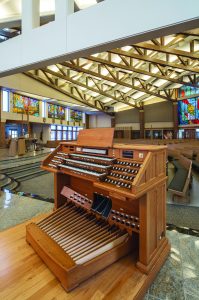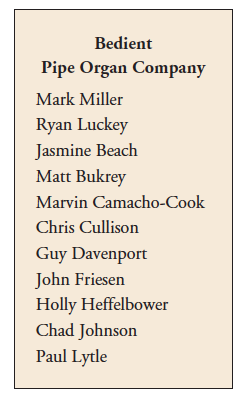St. Joseph Catholic Church
Lincoln, NE
Bedient Pipe Organ Company • Lincoln, NE
By Ryan Luckey and Mark Miller

We are often asked, “What is the most rewarding part of building a pipe organ?” People usually expect us to reply by describing the thrill of hearing the new organ as it plays music that was written specifically for the type of instrument we have just built. But they are surprised to hear our actual answer: “It’s the collaboration and the people we get to work with.” Working closely with the client to identify their needs and developing a plan to supply those needs results in the most successful and rewarding outcomes for everyone involved.
St. Joseph Catholic Parish of Lincoln, Nebraska, was established in 1979, and an electronic organ was installed. As the parish continued to grow, the need for larger facilities became apparent. A new church was built on the same property and was dedicated in 2000.
The new church is very modern, with clean, simple lines, an exposed-beam ceiling, and many windows filling the space with natural light. The architect planned space for a pipe organ at the front of the church behind the altar; but funding was not immediately available, and the electronic organ was brought from the old church. By 2012, the electronic organ had deteriorated to the point that it was unusable. A major charitable gift was received for the purchase of a pipe organ, and an organ committee was formed. “Purchasing a pipe organ suitable for leading worship that would serve the parish well into the future was a goal for several years of our music ministry and pastor, Msgr. Liam Barr,” according to Mike Zeleny, director of music ministry.

The organ committee sought the advice of a number of consultants as they began their work. Most determined that the space designed for an organ at the front of the chancel would be extremely challenging to work with. The church received several proposals for freestanding mechanical-action organs, all of which were to be placed in the rear corner of the church.
The Bedient Pipe Organ Company was also asked for a proposal. We considered a mechanical-action organ as well, but that would have brought its own difficulties. The rear corner was the only possible space for such an organ. Placing it there required sacrificing at least four pews and felt out of place aesthetically. It also would have left the musicians scurrying between organ and piano and choir loft. Poor visibility and sightlines for the organist would make it impossible to conduct the choir from the organ. Ultimately, we agreed with the parish leaders that placing the organ in the space prepared for it at the front of the chancel was the best option. We were confident in our ability to design and build a successful instrument for that space.
It was a pleasure to work closely with the music ministry leadership of St. Joseph’s to identify their goals and objectives for a successful organ project. The organ’s primary use is to lead worshipers during Mass. The parish has an active choral program, with several choirs and numerous cantors, and the organ is used to accompany all. Performance of organ literature is a secondary priority. Through conversations with the parish musicians and our own experience as church musicians, we were able to develop plans and specifications that meet all of these goals.
This installation posed a number of challenges for our design team. First, the chancel was to remain unaltered. The organ was to be located behind the grill cloth, with no exposed facade. This meant that all of the pipes, windchests, and other components had to be lifted into the chamber through a 28-inch opening in the floor. The chamber is a quarter-circle, each leg measuring about 15 feet. Fortunately, the two rear walls are solid concrete, helping project the sound into the church. Our goal was to provide as many ranks as possible without compromising on tonal egress or service accessibility.

The room provides some acoustical challenges as well. Although the chamber is located on the central axis of the church, the wide, radiating room will diffuse the sound greatly. The church seats more than 500 worshipers, and we needed to fill the carpeted room evenly with the organ’s sound. The greatest challenge, however, was the location of the choir loft relative to the designated organ chamber. The choir is seated to the far left of the main space under a lower ceiling and around a corner from the main axis of the room. We knew it would be very difficult for the choir members to hear the organ.
We began in the chamber considering various layout options. There was clearly space to house a two-manual-and-pedal organ, but a third manual division was out of the question. The Great division needed to be placed centrally at the front of the chamber for the best sound projection. We realized that the Swell could be placed behind and above the Great, speaking both through and over that division. This kept both sides of the chamber available for the Pedal ranks.
Because the choir seating was so far from the organ, a small division of only a few ranks was needed to support the singers. We found space over a storage room immediately behind the choir loft. Clear, articulate flutes along with a Dulciana would be very useful, especially if these ranks could be enclosed. An exposed Principal could be used not only with the choir, but also to help draw the sound of the main organ into the room when coupled to the Great.

Our first thought was to make this a floating division on a two-manual instrument, but we quickly saw the opportunity to add some much-needed flexibility. The Great is limited in size, and knowing that a rich Principal chorus is needed for leading hymns, we did not want to compromise that. However, this left us with little space for gentler accompanimental stops outside the Swell division. We then had the idea to place the Choir division on a third manual and borrow some of the Swell stops. This was done solely to add flexibility for registrations and maximize the organ’s potential for accompanying the liturgy.
The Great division is based on our classic principal chorus. We increased the scale of these pipes considerably to enable the sound to better fill this large church without becoming strident. The principals are voiced with our signature warm, relaxed, “singing” tone quality. Principal-scaled mutations allow for rich variations. The Rohrflöte and Trompete are also signature Bedient stops with their colorful and round character.
In this organ, the Swell division was conceived first as a contrast to the Great and second, to provide incidental music throughout the Mass. The Principal chorus here is lighter, simpler, and more focused than the Great chorus. The Swell includes a complete Flute chorus with wide-scale mutations for interest and diversity. In addition to our classic French Trompette, the Swell includes an English Oboe. This is a new stop for us, developed specifically for this organ. Its rich fundamental tone enhances the ensemble with distant, smothered warmth. The unique layout made it possible to place expression shades on three sides of the enclosure for maximum effectiveness.

The Pedal division was also designed with versatility in mind. This organ boasts four ranks of 16′ flues, including another new stop for our firm, a wood Violon. Its light purr and prompt speech bring clarity to the bass line without overpowering softer stops on the manuals. Space limitations required us to place all the Pedal ranks on offset chests, but this created the opportunity to wire a Resultant from the Subbass and provide a Quinte 102/3 from the Contrebasse. Finally, the reeds add power and brilliance to full registrations.
Mike Zeleny reflects on the project: “We have been very pleased with our selection of Bedient. Our partnership was collaborative, and their artisans and representatives were terrific to work with. Watching the organ “grow” in Bedient’s workshop was fascinating, and doing business with a Nebraska-based company also added an economic-development benefit to the community.”
This project brought many challenges and opportunities for our firm. We are grateful to Mike Zeleny; the Rev. Msgr. Liam Barr, pastor; and all the staff and volunteers at St. Joseph Catholic Parish for their time, efforts, and collaboration on this project. Knowing that this organ not only meets but also exceeds the expectations of this parish makes this one of the most truly rewarding projects in our recent history.


Ryan Luckey, vice president and project manager, came to Bedient Pipe Organ with more than 15 years of experience in project management. He has a deep passion for organs and organbuilding with interests in a wide variety of periods and styles. He enjoys working with each client to find fresh and creative ways to meet their musical needs. He is studying organ and sings with two church choirs each Sunday.
Mark Miller has served as president and tonal director since the retirement of Gene Bedient in 2010. Prior to that, he was vice president of field operations, having been involved at Bedient Pipe Organ for more than 25 years. He earned a master of music degree in organ performance from the University of Nebraska at Lincoln. He is director of music and organist at First Christian Church, Lincoln.


